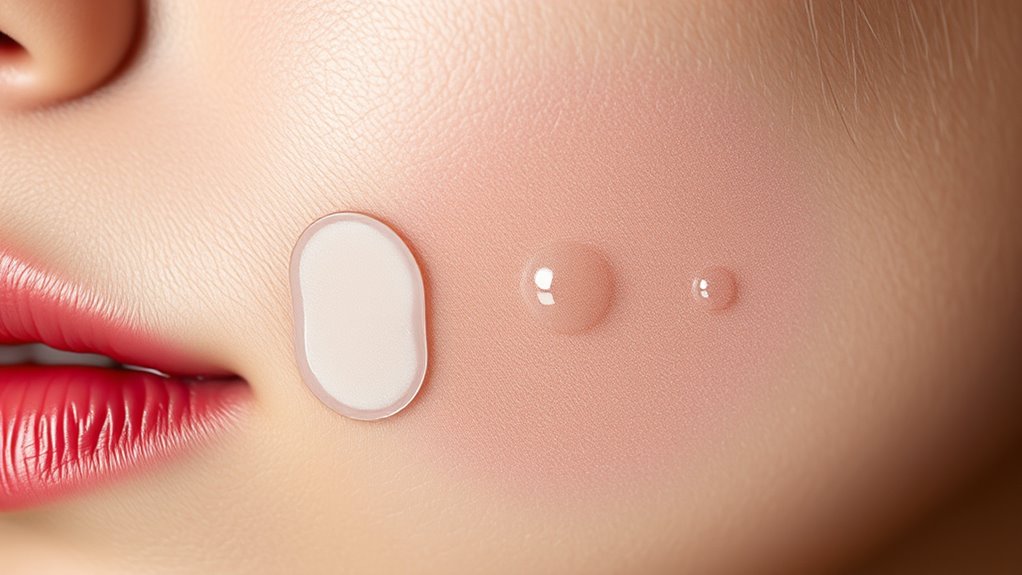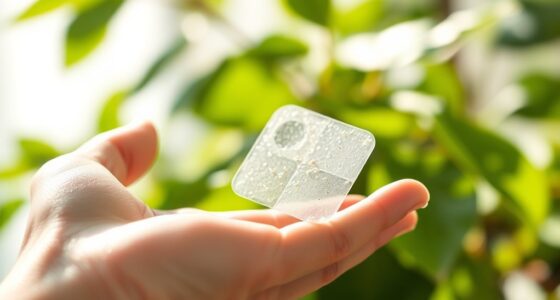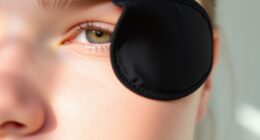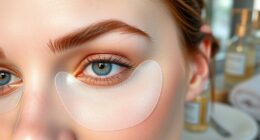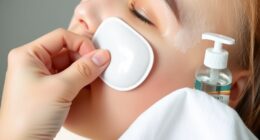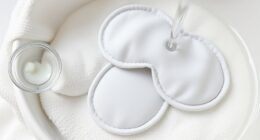Hydrocolloid acne patches work by creating a protective barrier that absorbs excess fluid, pus, and oil from blemishes, helping your skin heal faster. They gently draw out impurities without damaging your skin, reducing inflammation and redness. This keeps the area clean and guards against infection while preventing you from picking at spots, which can cause scars. If you’re curious about how this simple yet effective process accelerates healing, there’s more to explore ahead.
Key Takeaways
- Hydrocolloid patches act like sponges, absorbing excess fluid, pus, and impurities from pimples to promote faster healing.
- They create a protective barrier that shields blemishes from bacteria, dirt, and external irritants.
- The moist environment maintained by patches encourages skin cell regeneration and reduces inflammation.
- Their design ensures discreet, secure application, supporting both active treatment and daily prevention.
- By minimizing trauma and preventing picking, patches help reduce scarring and promote healthier skin recovery.
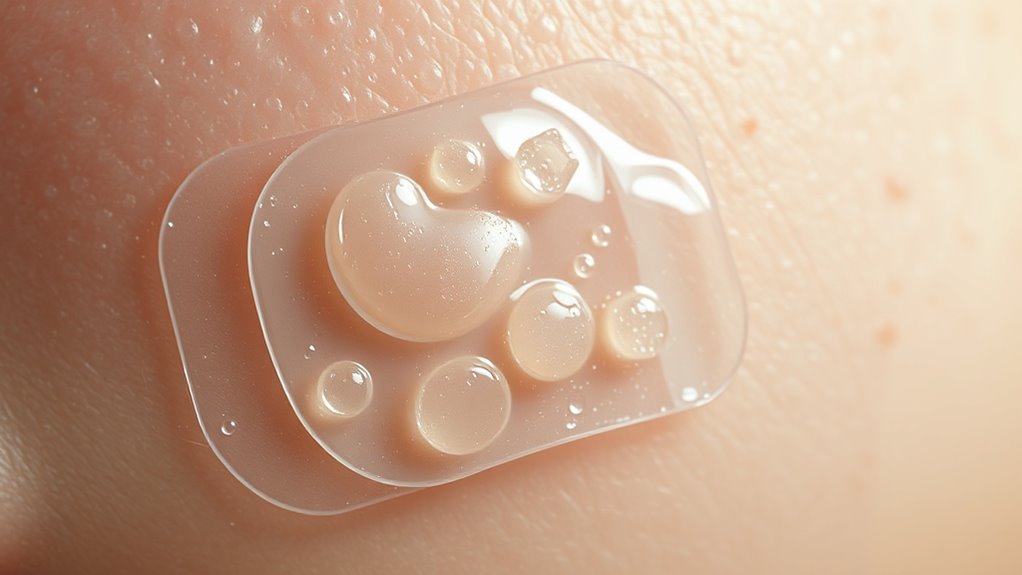
Hydrocolloid acne patches have become a popular solution for treating blemishes quickly and discreetly. You might wonder how these tiny stickers work so effectively. At their core, they create a protective barrier over your pimple, which helps to absorb excess fluid and pus, facilitating pimple extraction naturally. When you place a patch over a blemish, it draws out impurities while preventing you from picking at the spot, reducing the risk of scarring. This process is a crucial part of skin healing because it keeps the affected area clean and protected from bacteria and dirt, which can worsen inflammation or cause new breakouts.
Hydrocolloid patches create a protective barrier, absorb impurities, and promote faster, less invasive blemish healing.
The science behind pimple extraction with hydrocolloid patches is quite remarkable. Instead of manually squeezing or picking, which can damage skin and lead to scars, the patch gently pulls out the contents of the pimple through absorption. The hydrocolloid material acts like a sponge, soaking up excess fluid and dead skin cells, which accelerates the healing process. As the patch works, you’ll notice the blemish diminishing in size and redness, often appearing less inflamed than before. This gentle extraction minimizes trauma to your skin, promoting faster healing and reducing the likelihood of marks or scars left behind.
Furthermore, these patches support skin healing by creating an ideal environment for recovery. The hydrocolloid material maintains a moist environment that encourages cell regeneration, which is essential for quick and healthy skin repair. It also acts as a barrier against external irritants and bacteria, preventing further infection or irritation. This protection is especially helpful if you’re prone to picking or scratching, as it discourages unnecessary touching that can prolong healing or cause additional damage. Over time, consistent use of hydrocolloid patches can help improve the overall appearance of your skin by reducing inflammation and preventing the formation of new blemishes.
In addition, the discreet design of these patches means you can wear them during the day or overnight without drawing attention. They’re convenient and simple to apply, making pimple extraction and skin healing less stressful. The adhesive ensures the patch stays securely in place, even if you’re on the move, while the transparent nature allows you to monitor your blemish’s progress. With regular use, you’ll notice your skin becoming clearer, as the patches not only treat existing blemishes but also help prevent future breakouts by keeping your skin cleaner and less irritated. Additionally, choosing patches made from vetting materials ensures that they are safe and effective for sensitive skin types. Overall, hydrocolloid acne patches harness the power of targeted absorption, protection, and hydration to promote healthier, faster healing of your skin.
Frequently Asked Questions
Are Hydrocolloid Patches Suitable for All Skin Types?
You might wonder if hydrocolloid patches suit all skin types. Generally, they’re safe, but if you have skin sensitivity or prone to allergic reactions, it’s wise to do a patch test first. While many find them gentle and effective, some with sensitive skin could experience irritation. Always check the ingredients and consult a dermatologist if you’re unsure. This way, you can enjoy their benefits without risking adverse reactions.
How Long Should I Keep a Patch on for Best Results?
They say “good things come to those who wait,” and that’s true for hydrocolloid patches. For the best results, you should keep a patch on for about 6 to 8 hours or overnight, depending on the severity of your blemish. This patch duration allows the patch to absorb impurities effectively while giving your skin time to heal. Adjust the timing if needed, but don’t leave it on too long to avoid irritation.
Can Hydrocolloid Patches Be Used With Other Acne Treatments?
You can definitely use hydrocolloid patches with other acne treatments. Combining them creates treatment synergy, enhancing your overall results. Just make sure to apply the patch after using topical products like benzoyl peroxide or salicylic acid, and avoid layering thick creams underneath. This approach supports effective combination therapy, helping to reduce inflammation and absorb impurities while maximizing the benefits of each treatment. Always follow your dermatologist’s advice for safe, ideal results.
Do Hydrocolloid Patches Prevent Acne Scars?
Hydrocolloid acne patches mainly help with scar prevention by protecting your skin from picking and reducing inflammation. While they won’t completely prevent scars, they promote healing and minimize damage. By keeping the area moist and shielding it from bacteria, these patches support faster recovery. So, if you want to reduce the chances of scars forming, using hydrocolloid patches can be a helpful part of your skincare routine, especially for inflamed spots.
Are There Any Side Effects From Using Hydrocolloid Patches?
Imagine your skin as a delicate canvas, and using hydrocolloid patches is like gently wrapping it. While they’re effective, you might experience allergic reactions or skin irritation if your skin is sensitive. These patches can sometimes cause redness or discomfort, especially if left on too long. Always patch-test first, and remove the patch if you notice any adverse reactions to keep your skin healthy and happy.
Conclusion
Think of hydrocolloid acne patches as tiny guardians, quietly working behind the scenes to heal your skin’s battlefield. They pull out impurities like a magnet, shield your blemishes from further damage, and let your skin breathe easy. With each patch, you’re nurturing a small, powerful fortress of healing. So, next time you reach for one, remember you’re tapping into a hidden science — a delicate dance of healing that transforms your skin story, one patch at a time.
